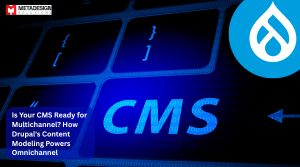In the evolving landscape of web development, the integration of robust content management systems (CMS) with dynamic front-end frameworks has become a standard for creating engaging digital experiences. Combining Drupal development services, a powerful and flexible CMS, with React, a leading JavaScript library for building user interfaces, allows developers to harness the strengths of both platforms. This integration facilitates the creation of decoupled architectures, where the back-end and front-end operate independently yet cohesively. This guide explores the process of setting up a decoupled architecture using Drupal and React, highlighting the benefits, implementation steps, best practices, and future trends in headless CMS development.
Understanding Decoupled Architecture
A decoupled architecture separates the back-end CMS from the front-end presentation layer. In this setup, Drupal manages content creation, storage, and management, while React handles the user interface and client-side interactions. Communication between the two layers occurs through APIs, enabling seamless data exchange and rendering.
Benefits of Decoupling Drupal and React
- Flexibility: Developers can choose the most suitable technologies for both back-end and front-end development, optimizing each layer for its specific role.
- Performance: React’s efficient rendering and state management contribute to faster and more responsive user interfaces.
- Scalability: The independent nature of the layers allows for easier scaling and maintenance of the application.
- Enhanced User Experience: Leveraging React’s capabilities enables the creation of rich, interactive interfaces that enhance user engagement.
Setting Up a Decoupled Drupal and React Application
Prerequisites
Before starting, ensure you have the following:
- Drupal Installation: A running instance of Drupal 9 or 10.
- Node.js Environment: Node.js installed on your system to run React applications.
- Basic Knowledge: Familiarity with JavaScript, React, and Drupal’s administrative interface.
Step 1: Configure Drupal as a Headless CMS
- Enable JSON:API Module: Drupal’s core includes the JSON:API module, which exposes entities as JSON endpoints. Ensure it’s enabled by navigating to Extend and activating the JSON:API module.
Set Up CORS (Cross-Origin Resource Sharing): To allow your React application to fetch data from Drupal, configure CORS by editing the services.yml file:
yaml code:
cors.config:
enabled: true
allowedHeaders: ['*']
allowedMethods: ['GET', 'POST', 'PATCH', 'DELETE', 'OPTIONS']
allowedOrigins: ['*']
exposedHeaders: true
maxAge: 1000
supportsCredentials: false
Build Dynamic Web Experiences with Drupal and React
Looking to create a decoupled architecture for your web application? Schedule a consultation with MDS to seamlessly integrate Drupal and React for a flexible, scalable solution.
2. Adjust the allowedOrigins to match your React application’s domain in a production environment.
3. Create and Manage Content: Utilize Drupal’s admin interface to create content types and add content. These will be accessible via JSON:API endpoints.
Step 2: Set Up the React Application
Initialize React Project: Create a new React application using Create React App:
bash code:
npx create-react-app my-react-app
1. Navigate to the project directory:
bash code:
cd my-react-app
Install Required Packages: To interact with Drupal’s JSON:API, you can use libraries like axios for HTTP requests:
bash code:
npm install axios
2. Configure Environment Variables: Create a .env file in the root of your React project and add your Drupal site’s base URL:
ini
REACT_APP_DRUPAL_BASE_URL=https://your-drupal-site.com
3. Replace https://your-drupal-site.com with your actual Drupal URL.
Step 3: Fetch Data from Drupal in React
Set Up Axios Instance: In your React project, create a services directory and add a api.js file:
javascript
import axios from 'axios';
const api = axios.create({
baseURL: process.env.REACT_APP_DRUPAL_BASE_URL + '/jsonapi',
});
export default api;
1. Fetch and Display Data: In your React components, use the api instance to fetch data. For example, to retrieve articles:
javascript
import React, { useEffect, useState } from 'react';
import api from '../services/api';
const Articles = () => {
const [articles, setArticles] = useState([]);
useEffect(() => {
const fetchArticles = async () => {
try {
const response = await api.get('/node/article');
setArticles(response.data.data);
} catch (error) {
console.error('Error fetching articles:', error);
}
};
fetchArticles();
}, []);
return (
<div>
{articles.map((article) => (
<div key={article.id}>
<h2>{article.attributes.title}</h2>
<p>{article.attributes.body.summary}</p>
</div>
))}
</div>
);
};
export default Articles;
Best Practices for Decoupled Drupal and React Development
- Security Measures: Sanitize user inputs and utilize Drupal’s API functions to prevent security vulnerabilities.
- Performance Optimization: Implement caching strategies and optimize API requests to enhance application performance.
- Caching Strategies: Utilize Drupal’s internal page and views caching, and set cache headers on your JSON:API responses. You can also implement client-side caching in React using libraries like SWR or React Query for optimal performance and user experience.
- Lazy Loading and Code Splitting: Use React features like dynamic import() and React.lazy() to split code and load components as needed.
- Minify API Payloads: Use Drupal’s JSON:API Extras module to control what fields are exposed via the API, reducing unnecessary data sent to the frontend.
Implementing Real-Time Features
For dynamic or real-time updates (e.g., live chat, notifications, dashboards), consider:- WebSockets: Implement a Node.js server that works alongside your React app and listens to updates from Drupal via webhooks or cron jobs.
- Polling: Use React to poll the Drupal API at intervals (though this is less efficient).
- GraphQL Subscriptions (Advanced): If you’re using Drupal’s GraphQL module, subscriptions can enable real-time data updates via WebSockets.
SEO Considerations in Decoupled Architectures
Search engine optimization is critical, especially in headless sites where content isn’t always rendered on the server by default.Options to Improve SEO:
- Server-Side Rendering (SSR): Use Next.js instead of Create React App if you need SSR or static site generation (SSG) for SEO and performance benefits. It renders React pages on the server before sending them to the client.
- Metadata Handling: Use the <Helmet> or next/head component to inject meta tags dynamically based on Drupal content.
- Sitemaps and Robots: Generate dynamic sitemaps in React using API data or keep this responsibility in Drupal and expose it at /sitemap.xml.
- Canonical URLs: Use Drupal’s PathAuto module to manage content aliases and pass canonical info to React.
Authentication Between React and Drupal
If your app requires user authentication (e.g., dashboard, user-specific content):- Use Drupal’s Simple OAuth module to issue secure access tokens.
- In React, store and manage these tokens in localStorage or HttpOnly cookies (the latter is more secure).
- Secure API routes with permission checks using user roles and custom access callbacks in Drupal.
Multilingual & i18n Support
Both Drupal and React offer multilingual support:- Enable Drupal’s core multilingual modules: Content Translation, Interface Translation, Language.
- In React, use i18next or FormatJS to manage language files.
- Use Accept-Language headers to dynamically fetch translated content from Drupal JSON:API.
Deployment Strategy
You’ll need to deploy the two parts separately but in sync:Drupal Backend
- Host on platforms like Acquia, Pantheon, or traditional LAMP stack.
- Use Git for configuration management and CI/CD pipelines.
React Frontend
- Host on platforms like Vercel, Netlify, or AWS Amplify.
- Use environment variables to point to your live Drupal JSON:API endpoint.
Decoupled Preview Workflows
Implement Drupal’s “Content Preview” by:- Using the Decoupled Preview module.
- Enabling editors to see a live preview in React using preview tokens or secure iframe embeds.
Real-World Use Cases
1. Publishing Platforms
E.g., media sites or magazines use Drupal for content workflows and React for rich, fast-rendering frontend experiences.2. SaaS Dashboards
Custom admin panels built in React consume data and permissions from Drupal, which manages user roles and access.3. Multichannel Commerce
Drupal Commerce + React = modern headless commerce. You can use one backend for both website and mobile app frontends.4. Government or NGO Portals
They often need scalable content moderation systems (Drupal) with performant, accessible, and mobile-first UIs (React).Challenges & Mitigations
| Challenge | Mitigation Strategy |
| Data syncing issues | Use webhooks or periodic API calls |
| Authentication token leakage | Use HttpOnly cookies and secure OAuth |
| SEO limitations in CSR | Move to SSR with Next.js |
| Complex editorial workflows in headless | Keep Drupal admin UI for editors |
| Performance lags on large API calls | Paginate & cache results, use JSON:API Extras |
Conclusion: Why Drupal + React is a Magic Combination
In 2025, decoupled architectures are more than a trend—they’re the future of flexible, high-performance, omnichannel content delivery.Pairing Drupal’s enterprise-grade content management with React’s modern component based rendering allows you to:- Craft blazing-fast, interactive frontends
- Empower content editors with best-in-class backend workflows
- Scale efficiently across devices and platforms
- Future-proof your tech stack for rapid innovation
Related Hashtags:
#Drupal10 #ReactJS #DecoupledArchitecture #HeadlessCMS #DrupalReact #JSONAPI #FrontendDevelopment #CMSIntegration #NextGenCMS #DecoupledDrupal #WebPerformance #ModernWebStack #FullStackDevelopment



